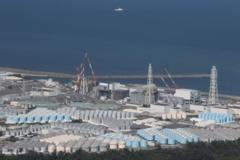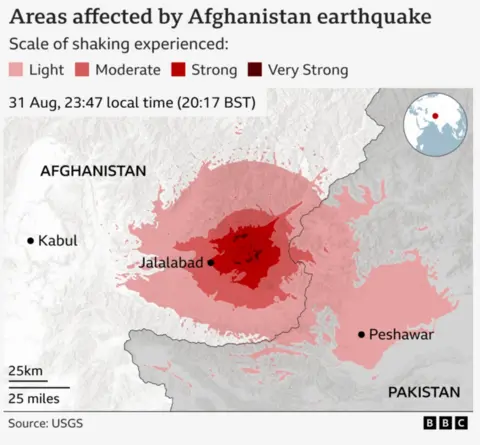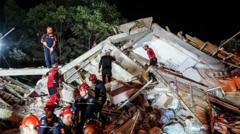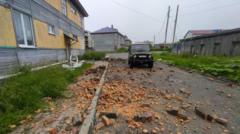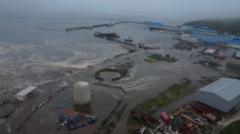The Fukushima nuclear plant's operator announced early Wednesday that all personnel had been evacuated as tsunami warnings were issued across multiple regions in Japan. This precaution followed an 8.7 magnitude earthquake that struck near Russia's far eastern coast, raising alarms across the Pacific.
For residents in Fukushima prefecture, this warning evokes haunting memories of the catastrophic events of March 2011, when a 9.0 magnitude earthquake and the subsequent tsunami claimed over 18,000 lives. That disaster flooded the nuclear plant, leading to overheating and meltdowns due to the failure of emergency generators. More than a decade later, the region is still coping with the aftermath, as approximately 880 metric tons of hazardous nuclear material remain at the site, presenting substantial decommissioning challenges.
After the major quake and tsunami in 2011, the Japanese government established a 30-km exclusion zone around the plant, forcing over 150,000 people to evacuate and restricting access to substantial areas. As far as cleaning up the waste is concerned, the removal of melted fuel and radioactive material from the facility is projected to take a staggering 30 to 40 years, with costs likely rising to around 21.5 trillion yen (approximately $145 billion). The Tokyo Electric Power Company (Tepco) has further announced that the commencement of full-scale removal operations would be deferred until at least 2037.
Despite their ongoing efforts, skepticism remains among experts regarding the feasibility of the ambitious timelines put forth by Tepco. The persistent issue of contaminated water storage adds another layer of complexity, with over 1,000 tanks filled with polluted water on site. This year, despite pushback from environmentalists, Tepco began releasing treated wastewater into the ocean, claiming it poses a minimal environmental threat.
In a contrasting move, Japan's government has been signaling a pivot back towards reliance on nuclear energy to meet increasing energy demands from various sectors, like AI and semiconductor production. Recently, Kansai Electric Power proposed exploring the construction of a new reactor, formerly shelved due to Fukushima's catastrophic legacy. However, the recent tsunami warnings are expected to tempers public support for such initiatives.
Tsunami waves are reported to have reached parts of Fukishima and other coastal regions, raising concerns for local residents. As waves could reach heights of 3 meters (around 9 feet) in some areas, precautionary evacuations are already in motion in light of the threat posed by Japan's unpredictable seismic activity. The nation, situated on the Ring of Fire, experiences over 1,500 earthquakes annually, reinforcing the fears surrounding major seismic incidents that could trigger devastating tsunamis.
For residents in Fukushima prefecture, this warning evokes haunting memories of the catastrophic events of March 2011, when a 9.0 magnitude earthquake and the subsequent tsunami claimed over 18,000 lives. That disaster flooded the nuclear plant, leading to overheating and meltdowns due to the failure of emergency generators. More than a decade later, the region is still coping with the aftermath, as approximately 880 metric tons of hazardous nuclear material remain at the site, presenting substantial decommissioning challenges.
After the major quake and tsunami in 2011, the Japanese government established a 30-km exclusion zone around the plant, forcing over 150,000 people to evacuate and restricting access to substantial areas. As far as cleaning up the waste is concerned, the removal of melted fuel and radioactive material from the facility is projected to take a staggering 30 to 40 years, with costs likely rising to around 21.5 trillion yen (approximately $145 billion). The Tokyo Electric Power Company (Tepco) has further announced that the commencement of full-scale removal operations would be deferred until at least 2037.
Despite their ongoing efforts, skepticism remains among experts regarding the feasibility of the ambitious timelines put forth by Tepco. The persistent issue of contaminated water storage adds another layer of complexity, with over 1,000 tanks filled with polluted water on site. This year, despite pushback from environmentalists, Tepco began releasing treated wastewater into the ocean, claiming it poses a minimal environmental threat.
In a contrasting move, Japan's government has been signaling a pivot back towards reliance on nuclear energy to meet increasing energy demands from various sectors, like AI and semiconductor production. Recently, Kansai Electric Power proposed exploring the construction of a new reactor, formerly shelved due to Fukushima's catastrophic legacy. However, the recent tsunami warnings are expected to tempers public support for such initiatives.
Tsunami waves are reported to have reached parts of Fukishima and other coastal regions, raising concerns for local residents. As waves could reach heights of 3 meters (around 9 feet) in some areas, precautionary evacuations are already in motion in light of the threat posed by Japan's unpredictable seismic activity. The nation, situated on the Ring of Fire, experiences over 1,500 earthquakes annually, reinforcing the fears surrounding major seismic incidents that could trigger devastating tsunamis.

